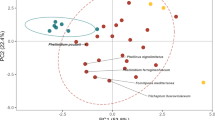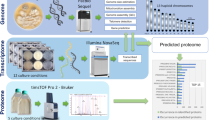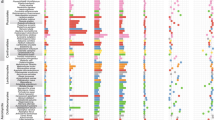Abstract
Fungal peroxidases (ClassII) have a key role in degrading recalcitrant polyphenolic compounds in boreal forest wood, litter and humus. To date, their occurrence and activity have mainly been studied in a small number of white-rot wood decomposers. However, peroxidase activity is commonly measured in boreal forest humus and mineral soils, in which ectomycorrhizal fungi predominate. Here, we used degenerate PCR primers to investigate whether peroxidase-encoding genes are present in the genomes of a wide phylogenetic range of ectomycorrhizal taxa. Cloning and sequencing of PCR products showed that ectomycorrhizal fungi from several different genera possess peroxidase genes. The new sequences represent four major homobasidiomycete lineages, but the majority is derived from Cortinarius, Russula and Lactarius. These genera are ecologically important, but consist mainly of non-culturable species from which little ecophysiological information is available. The amplified sequences contain conserved active sites, both for folding and substrate oxidation. In some Cortinarius spp., there is evidence for gene duplications during the evolution of the genus. ClassII peroxidases seem to be an ancient and a common feature of most homobasidiomycetes, including ectomycorrhizal fungi. Production of extracellular peroxidases may provide ectomycorrhizal fungi with access to nitrogen sequestered in complex polyphenolic sources.
Similar content being viewed by others
Log in or create a free account to read this content
Gain free access to this article, as well as selected content from this journal and more on nature.com
or
References
Aerts R . (1995). The advantages of being evergreen. Trends Ecol Evol 10: 402–407.
Altschul SF, Madden TL, Schaffer AA, Zhang JH, Zhang Z, Miller W et al. (1997). Gapped BLAST and PSI-BLAST: a new generation of protein database search programs. Nucleic Acids Res 25: 3389–3402.
Baldrian P . (2006). Fungal laccases—occurrence and properties. FEMS Microbio Rev 30: 215–242.
Bao W, Omalley DM, Whettn R, Sederoff RR . (1993). A laccase associated with lignification in loblolly-pine xylem. Science 260: 672–674.
Bending GD, Read DJ . (1996). Nitrogen mobilization from protein polyphenol complex by ericoid and ectomycorrhizal fungi. Soil Biol Biochem 28: 1603–1612.
Bending GD, Read DJ . (1997). Lignin and soluble phenolic degradation by ectomycorrhizal and ericoid mycorrhizal fungi. Mycol Res 101: 1348–1354.
Binder M, Hibbet DS, Larsson KH, Larsson E, Langer E, Langer G . (2005). The phylogenetic distribution of resupinate forms across the major clades of mushroom-forming fungi (Homobasidiomycetes). System Biodivers 3: 113–157.
Chambers SM, Burke RM, Brooks PR, Cairney JWG . (1999). Molecular and biochemical evidence for manganese-dependent peroxidase activity in Tylospora fibrillosa. Mycol Res 103: 1098–1102.
Chenna R, Sugawara H, Koike T, Lopez R, Gibson TJ, Higgins DG et al. (2003). Multiple sequence alignment with the Clustal series of programs. Nucleic Acids Res 31: 3497–3500.
Dijkstra FA, Cheng WX . (2007). Interactions between soil and tree roots accelerate long-term soil carbon decomposition. Ecol Lett 10: 1046–1053.
Haselwandter K, Bobleter O, Read DJ . (1990). Degradation of C-14 labeled lignin and dehydropolymer of coniferyl alcohol by ericoid and ectomycorrhizal fungi. Arch Microbiol 153: 352–354.
Hatakka A . (1994). Ligin-modifying enzymes from selected white-rot fungi—production and role in lignin degradation. FEMS Microbiol Rev 13: 125–135.
Hibbett DS, Gilbert LB, Donoghue MJ . (2000). Evolutionary instability of ectomycorrhizal symbioses in basidiomycetes. Nature 407: 506–508.
Kirk TD, Farrell RL . (1987). Enzymatic combustion—the microbial degradation of lignin. Ann Rev Microbiol 41: 465–505.
Knudsen H, Versterholt J . (2008). Funga Nordica. Nordsvamp. Copenhagen, Denmark.
Koide RT, Sharda JN, Herr JR, Malcom GM . (2008). Ectomycorrhizal fungi and the biotrophy–saprotrophy continuum. New Phytol 178: 230–233.
Lindahl BD, Ihrmark K, Boberg J, Trumboe SE, Hogberg P, Stenlid J et al. (2007). Spatial separation of litter decomposition and mycorrhizal nitrogen uptake in a boreal forest. New Phytol 173: 611–620.
Lindahl BD, Taylor AFS . (2004). Occurrence of N-acetylhexosaminidase-encoding genes in ectomycorrhizal basidiomycetes. New Phytol 164: 193–199.
Lindahl BD, Taylor AFS, Finlay RD . (2002). Defining nutritional constraints on carbon cycling in boreal forests—towards a less ‘phytocentric’ perspective. Plant Soil 242: 123–135.
Lynch M, Conery JS . (2000). The evolutionary fate and consequences of duplicate genes. Science 290: 1151–1155.
Maijala P, Harrington TC, Raudaskoski M . (2003). A peroxidase gene family and gene trees in Heterobasidion and related genera. Mycologia 95: 209–211.
Martin F, Aerts A, Ahren D, Brun A, Danchin EGJ, Duchaussoy F et al. (2008). The genome of Laccaria bicolor provides insights into mycorrhizal symbiosis. Nature 452: 88–92, U7.
Martinez AT . (2002). Molecular biology and structure–function of lignin-degrading heme peroxidases. Enzyme Microb Technol 30: 425–444.
Morgenstern I, Klopman S, Hibbett DS . (2008). Molecular evolution and diversity of lignin degrading heme peroxidases in the agaricomycetes. J Mol Evol 66: 243–257.
Myneni RB, Dong J, Tucker CJ, Kaufmann RK, Kauppi PE, Liski J et al. (2001). A large carbon sink in the woody biomass of Northern forests. Proc Natl Acad Sci USA 98: 14784–14789.
Northup RR, Yu ZS, Dahlgren RA, Vogt KA . (1995). Polyphenol control of nitrogen release from pine litter. Nature 377: 227–229.
Nygren CMR, Eberhardt U, Karlsson M, Parrent JL, Lindahl BD, Taylor AFS . (2008). Growth on nitrate and occurrence of nitrate reductase-encoding genes in a phylogenetically diverse range of ectomycorrhizal fungi. New Phytol 180: 875–889.
Passardi F, Bakalovic N, Teixeira FK, Margis-Pinheiro M, Penel C, Dunand C . (2007a). Prokaryotic origins of the non-animal peroxidase superfamily and organelle-mediated transmission to eukaryotes. Genomics 89: 567–579.
Passardi F, Theiler G, Zamocky M, Cosio C, Rouhier N, Teixeira F et al. (2007b). PeroxiBase: the peroxidase database. Phytochemistry 68: 1605–1611.
Pérez-Boada M, Ruiz-Duenas FJ, Pogni R, Basosi R, Choinowski T, Martinez MJ et al. (2005). Versatile peroxidase oxidation of high redox potential aromatic compounds: site-directed mutagenesis, spectroscopic and crystallographic investigation of three long-ranged electron transfer pathways. J Mol Biol 354: 385–402.
Rayner ADM, Boddy L, Dowson CG . (1987). Genetic interactions and developmental versatility during establishment of decomposer basidiomycetes in wood and tree litter. In: Fletcher M, Gray TRG, Jones JG (eds). Symposium of the Society for General Microbiology, 41. Ecology of Microbial Communities. Cambridge University Press: New York, USA, Cambridge, UK.
Read DJ . (1991). Mycorrhizas in ecosystems. Experientia 47: 376–391.
Robinson JM . (1996). Atmospheric bulk chemistry and evolutionary megasymbiosis. Chemosphere 33: 1641–1653.
Ruiz-Duenas FJ, Martinez MJ, Martinez AT . (1999). Molecular characterization of a novel peroxidase isolated from the ligninolytic fungus Pleurotus eryngii. Mol Microbiol 31: 223–235.
Sinsabaugh RL . (2005). Fungal enzymes at the community scale. In: Dighton J, White JF, Oudemans P (eds). The Fungal Community. Its Organization and Role in the Ecosystem, 3rd edn. Taylor & Francis: Boca Raton, FL. pp 349–360.
Steffen KT, Hatakka A, Hofrichter M . (2002). Degradation of humic acids by the litter-decomposing basidiomycetes Collybia dryophila. Appl Environ Microbiol 68: 3442–3448.
Swofford DL . (2003). PAUP*. Phylogenetic Analysis Using Parsimony (*and Other Methods). Sinaur Associates: Sunderland, MA.
Talbot JM, Allison SD, Treseder KK . (2008). Decomposers in disguise: mycorrhizal fungi as regulators of soil C dynamics in ecosystems under global change. Funct Ecol 22: 955–963.
Trojanowski J, Haider K, Huttermann A . (1984). Decomposition of C-14 labeled lignin, holocellulose and lignocellulose by mycorrhizal fungi. Arch Microbiol 139: 202–206.
Wapinski I, Pfeffer A, Friedman N, Regev A . (2007). Natural history and evolutionary principles of gene duplication in fungi. Nature 449: 54–61.
Acknowledgements
We gratefully acknowledge the Swedish University of Agricultural Sciences for financial support of the project. Further, we thank Katarina Ihrmark for practical help and advice during the laboratory work, Rimvydas Vasaitis for kindly providing the culture of Phellinus ferrugineofuscus and Karina Clemmensen and Petra Fransson for critical reading of the paper.
Author information
Authors and Affiliations
Corresponding author
Additional information
Supplementary Information accompanies the paper on The ISME Journal website (http://www.nature.com/ismej)
Supplementary information
Rights and permissions
About this article
Cite this article
Bödeker, I., Nygren, C., Taylor, A. et al. ClassII peroxidase-encoding genes are present in a phylogenetically wide range of ectomycorrhizal fungi. ISME J 3, 1387–1395 (2009). https://doi.org/10.1038/ismej.2009.77
Received:
Revised:
Accepted:
Published:
Issue date:
DOI: https://doi.org/10.1038/ismej.2009.77
Keywords
This article is cited by
-
Plant functional type shapes nitrogen availability in a regenerating forest
Plant and Soil (2024)
-
Diversity analysis of leaf endophytic fungi and rhizosphere soil fungi of Korean Epimedium at different growth stages
Environmental Microbiome (2022)
-
Advanced research tools for fungal diversity and its impact on forest ecosystem
Environmental Science and Pollution Research (2022)
-
Selective delignification of poplar wood with a newly isolated white-rot basidiomycete Peniophora incarnata T-7 by submerged fermentation to enhance saccharification
Biotechnology for Biofuels (2021)
-
Ectomycorrhizal access to organic nitrogen mediates CO2 fertilization response in a dominant temperate tree
Nature Communications (2021)



